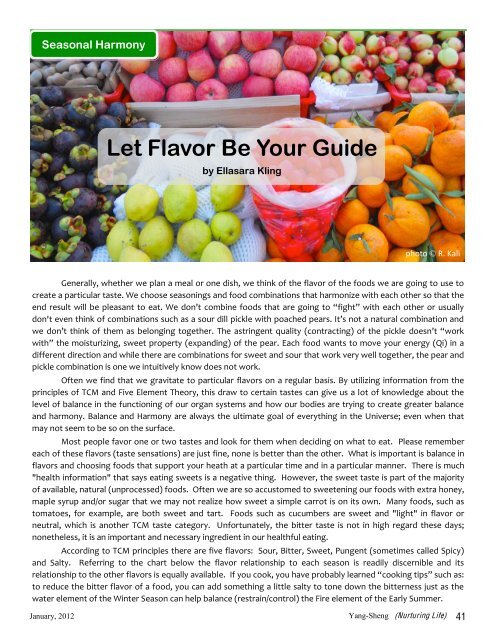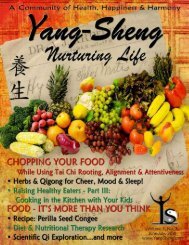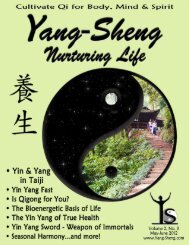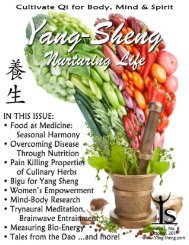Download PDF - Yang-Sheng
Download PDF - Yang-Sheng
Download PDF - Yang-Sheng
You also want an ePaper? Increase the reach of your titles
YUMPU automatically turns print PDFs into web optimized ePapers that Google loves.
Seasonal Harmony<br />
Let Flavor Be Your Guide<br />
by Ellasara Kling<br />
photo © R. Kali<br />
Generally, whether we plan a meal or one dish, we think of the flavor of the foods we are going to use to<br />
create a particular taste. We choose seasonings and food combinations that harmonize with each other so that the<br />
end result will be pleasant to eat. We don’t combine foods that are going to “fight” with each other or usually<br />
don't even think of combinations such as a sour dill pickle with poached pears. It’s not a natural combination and<br />
we don’t think of them as belonging together. The astringent quality (contracting) of the pickle doesn’t “work<br />
with” the moisturizing, sweet property (expanding) of the pear. Each food wants to move your energy (Qi) in a<br />
different direction and while there are combinations for sweet and sour that work very well together, the pear and<br />
pickle combination is one we intuitively know does not work.<br />
Often we find that we gravitate to particular flavors on a regular basis. By utilizing information from the<br />
principles of TCM and Five Element Theory, this draw to certain tastes can give us a lot of knowledge about the<br />
level of balance in the functioning of our organ systems and how our bodies are trying to create greater balance<br />
and harmony. Balance and Harmony are always the ultimate goal of everything in the Universe; even when that<br />
may not seem to be so on the surface.<br />
Most people favor one or two tastes and look for them when deciding on what to eat. Please remember<br />
each of these flavors (taste sensations) are just fine, none is better than the other. What is important is balance in<br />
flavors and choosing foods that support your heath at a particular time and in a particular manner. There is much<br />
"health information" that says eating sweets is a negative thing. However, the sweet taste is part of the majority<br />
of available, natural (unprocessed) foods. Often we are so accustomed to sweetening our foods with extra honey,<br />
maple syrup and/or sugar that we may not realize how sweet a simple carrot is on its own. Many foods, such as<br />
tomatoes, for example, are both sweet and tart. Foods such as cucumbers are sweet and "light" in flavor or<br />
neutral, which is another TCM taste category. Unfortunately, the bitter taste is not in high regard these days;<br />
nonetheless, it is an important and necessary ingredient in our healthful eating.<br />
According to TCM principles there are five flavors: Sour, Bitter, Sweet, Pungent (sometimes called Spicy)<br />
and Salty. Referring to the chart below the flavor relationship to each season is readily discernible and its<br />
relationship to the other flavors is equally available. If you cook, you have probably learned “cooking tips” such as:<br />
to reduce the bitter flavor of a food, you can add something a little salty to tone down the bitterness just as the<br />
water element of the Winter Season can help balance (restrain/control) the Fire element of the Early Summer.<br />
January, 2012 <strong>Yang</strong>-<strong>Sheng</strong> (Nurturing Life) 41













